
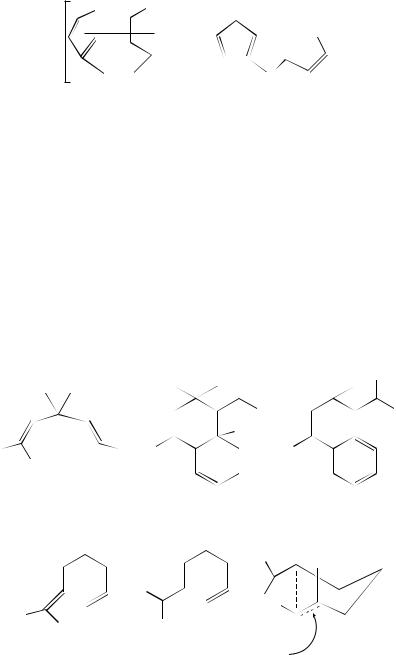
4. Photochemistry of non-conjugated dienes |
267 |
|||
|
|
|
|
|
|
Ph |
|
||
|
|
|
||
|
DCA |
Ph |
|
|
|
|
|||
(CH2)n |
|
(CH2)n |
|
|
(65) |
|
|
||
|
(66) |
|
||
Zimmerman and Hofacker29 have studied the photochemically induced SET reactivity (using DCA or DCN) of the heavily arylated 1,4-dienes 67. The radical cations formed by this treatment undergo regioselective cyclization to the cyclic radical cation 68 that ultimately affords the final products 69. Other dienes with 1,1-diphenyl substituents are also reactive. Thus 1,1-diphenylhepta-1,6-diene (70) can be converted into its radical cation (71). This cyclizes under attack from the solvent acetonitrile (or propionitrile) via the six-membered transition state shown in 72. This affords the adduct 73. Cyclization of the radical cation is not exclusive and trapping by adventitious water, affording the alcohol 74, takes pace in competition. The length of the chain linking the two alkene moieties is fairly critical for the success of the reaction. When this is shortened to two methylene groups, only the alcohol 75 is formed on irradiation of the diene 7630. Multiple phenyl substituents on the diene as in 77 influence the eventual outcome of the reaction. Cyclization still involves a radical cation (78) that is formed on irradiation (through Pyrex at > 280 nm) in acetonitrile/benzene in the presence of DCB as the electron-accepting sensitizer. However, attack on a phenyl group is the principal reaction mode and this yields 79 in 87%31.
|
|
|
|
|
Ar |
|
|
|
Ar |
|
|
|
|
|
|
|
• |
|
|
|
|
|
|
|
|
|
|
Ar |
|
|
|
Ar |
|
|
|
|
|
|
|||||
|
|
|
|
+ |
|
H |
|
|
|
|
Ph |
Ar Ph |
|
|
|
Ph |
|
|
|
|
|
|
|
|
|
|
|
|
|
|||
|
|
|
|
|
|
|
|
|||
Ph |
Ar |
|
|
|
|
|
|
|
|
|
|
(67) |
|
|
|
(68) |
|
(69) |
|||
Ar = p−XC6H4 |
|
|
|
|
|
|
|
|
|
|
X = H, MeO, Me, Cl, CN |
|
|
|
|
H |
|
|
|
|
|
|
|
|
|
|
|
|
|
|
|
|
|
|
|
|
|
|
Ph |
H |
|||
|
|
|
|
|
|
|
||||
|
Ph |
|
|
|
|
• |
|
|
|
|
|
+ • |
|
|
Ph H |
|
|
|
|
||
|
|
|
|
|
|
|
|
|
|
|
Ph |
Ph |
Ph |
|
+ |
|
|
|
|
||
|
|
|
|
|
|
|||||
|
|
|
H |
|
|
|
|
|||
|
|
|
|
|
|
|
|
|
|
|
|
(70) |
(71) |
|
|
CH3CN: |
(72) |
|
|||

268 |
|
William M. Horspool |
|
||
Ph |
Ph |
|
|
Ph |
|
|
|
OH |
|||
|
|
NHCOCH3 |
OH |
||
|
|
|
|||
Ph |
Ph |
|
|
Ph |
|
|
|
|
|||
(73) |
(74) |
|
|
(75) |
|
|
|
|
|
|
Ph |
Ph |
Ph |
|
|
|
|
|
|
|
Ph |
||
|
|
|
|
|
|
|
Ph |
Ph |
|
|
|
|
|
|
|
|
|
(76) |
|
(77) |
|
||
|
Ph |
Ph |
|
Ph Ph |
|
+ |
• |
|
|
|
|
|
|
|
|
|
|
|
|
|
|
|
|
|
|
|
|
|
|
|
|
|
|
|
|
Ph |
Ph |
H |
(78) |
|
(79) |
B. Norbornadienes and Related Systems
One of the interesting molecules that has been studied in considerable detail is norbornadiene (80). Much of this interest has been associated with the interactions between the double bonds of the system. Thus irradiation affords quadricyclane (81). This area of study will be discussed later in this chapter. The radical cation 82 can also be formed from both norbornadiene and quadricyclane by irradiation in acetonitrile/methanol solution with the DCB/phenanthrene sensitizer system. Several products (Scheme 2) are formed in low yield and it should be noted that there is little difference in the yields of products obtained from either starting material. However, it is evident that attack by methanol occurs from the exo face32.
|
+ • |
|
+ • |
|
|||
|
|
|
(80) |
(81) |
(82) |

|
4. Photochemistry of non-conjugated dienes |
269 |
||
|
|
|
OMe |
OMe |
MeO |
|
MeO |
Ar |
Ar |
|
|
|
||
|
Ar |
|
Ar |
|
norbornadiene |
6 |
5 |
6 |
3 |
quadricyclane |
5 |
4 |
4 |
2 |
|
|
|
Ar = p-NCC6H4 |
|
SCHEME 2
The cyclization of norbornadienes into quadricyclanes can also be achieved by electrontransfer sensitization by donation. Such a process obviously will form the radical anion of the norbornadiene. For the formation of the radical anion, suitable electron-accepting substituents must be attached to the norbornadiene skeleton as in the derivatives 83 and 84. The results using these derivatives have shown that a variety of sensitizers such as phenanthrene, anthracene, pyrene and N-methylcarbazole are effective although the most efficient was phenanthrene33. Other sensitizers such as acridine yellow and acridine orange are also effective. The photo-isomerization is accompanied by quenching of the fluorescence of the dye34. The mechanism by which the cyclization takes place using electron-donating sensitizers is thought to involve an exciplex of the radical-ion pair. The excited triplet state of the diene is produced by back electron transfer in the radical-ion pair within a solvent cage35. Intramolecular SET within a norbornadiene system is also a possibility and has been investigated using the norbornadienes 85. Here the influence of both chain length and conformation was assessed36,37.

 R1
R1
R2
(83) R1 = R2 = CN
(84) R1 = R2 = COOH or CO2Me

 CO2Me
CO2Me
N
 O(CH2)n
O(CH2)n
O
(85) n = 2−6
Dienes closely related to the norbornadiene system have also proved of interest in SETinduced reactions. Thus, the diene 86 can be transformed into the corresponding radical
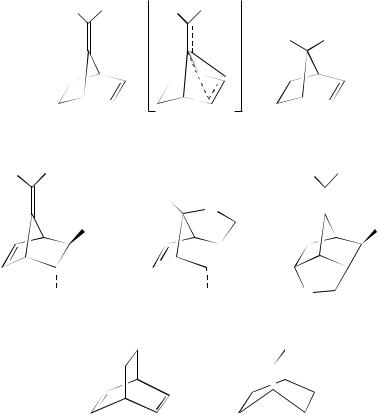
270 |
William M. Horspool |
cation 87 on irradiation in the presence of an electron-accepting sensitizer. This radical cation reacts with methanol to yield the ether 88. Such reactivity is reminiscent of the behaviour of the radical cation of norbornadiene under similar conditions. Intramolecular trapping of these non-classical radical cations has also been studied using the diene 89. The resultant radical cation formed by irradiation in the presence of a suitable electronaccepting sensitizer gives the two products 90 and 9138. Irradiation of the radical cation 92 with visible light brings about cyclization to the radical cation 9339.
|
|
|
|
|
|
+ |
Ph |
Ph |
|
Ph |
Ph |
|
• |
|
|
|
MeO CHPh2
|
(86) |
(87) |
(88) |
|
|
Ph |
Ph |
|
Ph Ph |
||
|
|
Ph2CH |
O |
|
|
|
|
|
|
||
|
|
|
|
|
|
|
CH2OH |
|
|
|
CH2OH |
|
CH2OH |
CH2OH |
O |
||||||||
(89) |
(90) |
|
|
|
(91) |
||||||
|
+ |
|
|
|
+ |
||||||
|
|
|
|
|
• |
|
|
|
|
|
• |
|
|
|
|
|
|
|
|
|
|
|
|
(92) |
(93) |
III.CYCLOBUTANE FORMATION
A.Copper(I) Triflate Controlled Reactions
One of the exciting areas that has gained importance over the recent decade is the photochemical cyclization of non-conjugated dienes in the presence of species that can act as templates. One such species that has been used is copper(I) salts. The earliest example of the use of copper salts in the intramolecular photocycloaddition of non-conjugated dienes is that described for cycloocta-1,5-diene. When this is irradiated in the presence

4. Photochemistry of non-conjugated dienes |
271 |
(94)
of copper(I) chloride, the tricyclic compound 94 is formed in 30% yield. The authors40 suggested that the cyclization to this product involved free radicals.
More modern studies have made use of copper(I) triflate (CuOTf) as the reagent. This compound is well known to form complexes with dienes and it provides a template on which cycloadditions can be effected41. Several examples of this type of cyclization have been reported and cycloadditions based on this approach provide a useful route to cyclobutane derivatives. Thus, a new stereochemical synthesis of grandisol has been developed using the copper(I)-catalysed cycloaddition of the dienol 95 to afford the isomeric bicycloheptenols 9642. The exo/endo ratio in this cyclization is solvent-dependent. The racemic grandisol (97) can be synthesized starting from the heptenol (96) in eight steps. A more detailed study by Langer and Mattay43 has reported on the use of the copper triflate controlled (2 C 2)-cycloaddition of 1,6-dienes such as the (S)-diene 98. This affords the two enantiomerically pure cyclobutane derivatives 99 and 100. These can be converted into enantiomerically pure (C)-grandisol (97) and the corresponding ( )-grandisol. The use of chiral copper catalysts was also examined. This only gave products with low enantiomeric excesses (ee) <5%. The authors43 reason that low ee values are due to the low reactivity of the chiral copper complexes.
OH
OH H
H
|
|
|
|
|
HO |
|
|
|
|
|
|
|
|
|
|
|
|
|
|
|
|
|
CH3 |
|
|
|
|
||
|
|
|
|
H |
|||||
|
|
|
|
||||||
CH3 |
|
|
|
||||||
|
|
|
|
|
|
|
|
||
(95) |
|
(96) |
|
(97) |
|
|
|
||
OH |
OH |
H |
HO |
H |
|||||
|
|
|
|
||||||
|
|
|
|
|
|
|
|
|
|
|
|
|
|
|
|
|
|
|
|
|
Me |
Me |
(98) |
(99) |
(100) |
The presence of an oxygen atom in the chain linking the two alkene moieties does not appear to affect the efficiency of the cyclizations encountered. Thus, the (2 C 2)- intramolecular cycloaddition of the divinyl ether 101a in ether solution with CuOTf

272 |
William M. Horspool |
affords a reasonable yield of 67% of the tetrahydrofuran derivative 102a. The influence of substituents was studied using 101b,c and stereoselectivity in the cycloaddition was observed44. Copper triflate controlled cyclizations of this type can be used to construct suitable key molecules for the synthesis of naturally occurring compounds. To this end the dienes 103 and 104 have been cyclized intramolecularly to yield the cyclobutanes 105 and 106, respectively, in moderate to good yields. The products from these reactions are key intermediates in the synthesis of natural products such as cedrene (107)45. Other examples of this type of cyclization have been used as a route to cyclopentanone derivatives. This involves the copper triflate influenced (2 C 2)-photocycloaddition of the dienes 108 to afford the cyclobutane derivatives 109. The stereochemistry of the cycloaddition was studied and it can be seen that the dienes 108a, 108c and 108d afford mixtures of exo and endo isomers while diene 108b yields only a single isomer. The conversion to the cyclopentanones that were the main target of the work is carried out by rearrangement of the products 10946,47. These adducts are key components in an approach to the synthesis of 9 12 -capnellene. Approaches to other systems involve the cyclization of the dienes 110 under the copper(I) controlled conditions. This affords the adducts 111 that can be transformed by thermal reactions into variously substituted derivatives of cyclopentane48.
R2
O
O O
OEt
O
(104)
R1 |
R2 |
R1 |
( )n |
||||||||
OEt |
|
|
|
|
|||||||
|
|
|
|
|
|
|
|
|
|
OEt |
|
|
|
|
|
|
|
O |
|
|
|
|
|
|
|
|
|
|
|
|
|
|
|
|
|
EtO |
|
|
|
|
|
||||||
|
|
|
|
|
|||||||
|
|
O |
|||||||||
|
|
|
|
|
|
|
H |
|
|
|
|
|
|
|
|
|
|
|
|
|
|
|
|
(101) |
|
|
(102) |
(103) |
|
||||||
(a)R1 = R2 = Et
(b)R1 = CH2CH2Ph, R2 = Me
(c)R1 = Et, R2 = Me
( )n |
O |
|
O |
Me |
Me |
|
|
|
|||
OEt |
|
|
|
|
|
|
|
|
|
OEt |
Me |
O |
|
|
|
H |
Me |
|
|
O |
|
||
|
|
|
|
|
|
(105) |
|
|
(106) |
|
(107) |
n = 2,3 or 1 |
|
|
|
|
|

|
|
4. Photochemistry of non-conjugated dienes |
273 |
|||||||||||||||||
|
|
Me R1 |
|
|
|
|
|
R1 |
|
|
|
|
|
|
|
|
||||
|
|
|
|
|
Me |
|
OEt |
|
|
|
|
|
|
|
||||||
|
|
O |
R2 |
|
O |
|
|
|
|
|
|
|
|
|
||||||
|
|
EtO |
|
|
|
|
|
|
|
|
|
|
|
|
||||||
|
|
|
|
|
|
|
|
|
|
|
|
|
|
|
|
|
||||
|
|
|
|
|
|
|
|
|
|
|
|
H |
R2 |
|
|
|
|
|
|
|
|
|
|
|
|
|
|
|
|
|
|
|
|
|
|
|
|
|
|
||
|
|
|
|
|
|
|
|
|
|
|
|
|
|
|
|
|
|
|
|
|
|
(108) |
|
|
|
|
|
|
|
(109) |
|
|
|
|
|
|
|
||||
|
|
R1 |
R2 |
|
|
yield (%) |
exo : endo |
|
||||||||||||
|
|
(a) Me |
Me |
41 |
|
2.5:1 |
|
|
|
|
|
|
|
|||||||
|
|
|
|
|
|
|
|
|
|
|
|
|
|
|||||||
|
|
(b) Me |
Ph |
53 |
|
0:100 |
|
|
|
|
|
|
||||||||
|
|
(c) Me |
Me |
52 |
|
2.2:1 |
|
|
|
|
|
|
|
|||||||
|
|
(d) PhCH2 |
Me |
52 |
|
3:1 |
|
|
|
|
|
|
|
|||||||
|
|
|
|
|
|
|
|
|
|
|
|
|
|
|
|
|
|
|
|
|
|
|
R1 |
|
|
|
n |
|
|
R |
1 R2 |
O |
|
|
|
n |
|||||
|
|
|
|
|
|
|
|
|
|
|||||||||||
|
|
|
|
|
|
|
|
|
|
|
|
|
||||||||
|
|
|
O |
|
|
|
|
|
|
|
|
|
|
H |
||||||
|
|
R2 |
|
|
|
|
|
|
|
|
|
|
||||||||
|
|
|
|
|
|
|
O |
|
|
|
|
|
|
|||||||
|
|
|
|
|
|
|
|
|
|
|
|
|
|
|
|
|
|
|
||
|
|
O |
|
|
|
|
|
|
|
|
|
|
|
|
|
|
|
|||
|
|
|
|
|
|
|
|
|
|
|
|
|
H |
|
|
|
|
|
|
|
|
(110) |
|
|
|
|
|
|
|
(111) |
|
|
|
|
|
|
|
||||
|
R1 |
R2 |
|
|
|
yield (%) |
|
|
|
|
|
|
|
|||||||
(a) Me |
|
|
|
|
|
n = 1 |
n = 2 |
|
||||||||||||
Me |
|
|
|
50 |
|
46 |
|
|
||||||||||||
(b) Me |
CH2CH2Ph |
|
|
|
59 |
|
45 |
|
|
|||||||||||
(c) Me |
CH2Ph |
|
|
|
70 |
|
40 |
|
|
|||||||||||
(d) |
|
− (CH2)4 − |
|
|
|
|
|
|
45 |
|
58 |
|
|
|||||||
(e) |
|
− (CH2)5 − |
|
|
|
|
|
|
60 |
|
57 |
|
|
|||||||
B. Cyclophane Syntheses
An interesting reaction that has been developed over the past decade is the application of (2 C 2)-cycloaddition reactions to the synthesis of cyclophanes49. One of the earliest examples of this is the selective conversion of the bis(arylalkenes) 112 into the adducts 113. The yield of product is dependent to some extent on the chain length separating the aryl groups and the best yield of 41% is obtained when the separation includes four methylene units (n D 4). Lower yields are recorded with the other derivatives. Mixtures of products are formed when the m-isomers 114 are used. This affords 115 and 116. The yields of these are better than those obtained from the p-isomers 11250,51. Nishimura and coworkers52 have examined the ease with which such cyclobutanes, e.g. 115, n D 2,
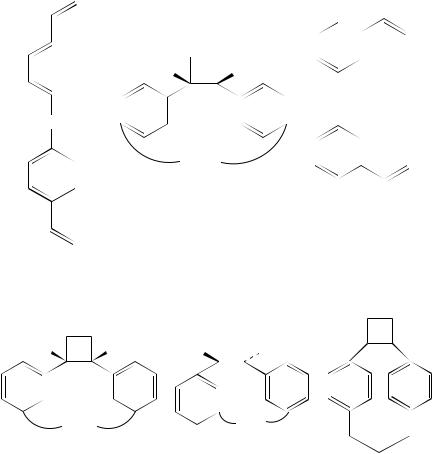
274 |
William M. Horspool |
undergo thermal reversal to starting material 114. Other more constrained systems have been synthesized by chemical modification of 115, n D 3. This yielded the derivative 117 as a mixture of exo- and endo-isomers53. Naphthalenophane analogues can also be obtained in moderate yield by the photochemical cyclization of the corresponding alkenes 118, 11954 and 12055. Phenanthrene-based cyclophanes can also be prepared in moderate yields by the intramolecular photocycloaddition of the vinylphenanthrene derivatives 121. The syn-cyclophanes 122 are formed exclusively56.
|
|
|
|
|
|
|
|
|
|
H |
H |
||||||
(CH2)n |
|
(CH2)n |
|
|
(CH2)n |
|||
|
|
|||||||
|
|
|
|
|
|
|||
|
|
|
|
|
|
|||
|
|
|
|
|
|
|
|
|
|
|
|
|
|
|
|
|
|
|
|
|
|
(114) |
||||
(113) |
||||||||
|
|
|
|
|
|
n = 2, 3, 4, 5 or 6 |
||
(112)
n = 3, 4, 5 or 6
H H H 
 H
H
(CH2)n |
(CH2)n |
(115) |
(116) |
(117)
Similar intramolecular cycloadditions are encountered where an ether linkage has been incorporated into the meta or para linking groups 123. In these cyclizations the better yields were obtained from the para-attached systems. The yields obtained are again dependent on the chain length of the separator and are indicated below the appropriate structures (124)57. Other hetero-atom-substituted cyclophanes (125) can be obtained by irradiation of the divinyl compounds (126)58,59. The use of tin and germanium derivatives
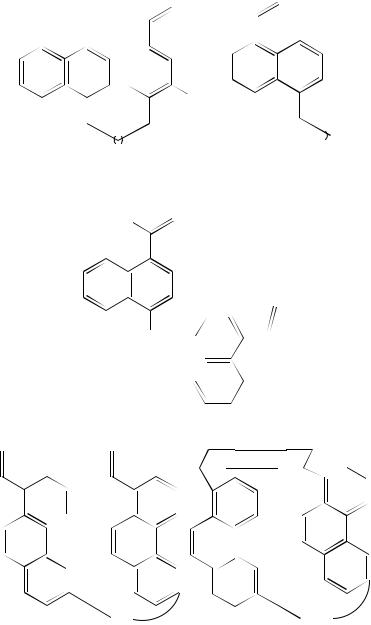
4. Photochemistry of non-conjugated dienes |
275 |
|
R |
|
||
|
|
|
|
|
|
|
|
|
|
|
R |
|
||
|
|
|||
n |
(119) |
2CH2 |
||
|
|
|||
(118)(a) n = 1, R = H
(b)n = 1, 2, or 3 RR = (CH CH)2
CH)2
Me
(CH2)n 
 Me
Me
(120) n = 3 or 4
CH2 |
(CH2)n |
(121) |
(122) n = 3 49% |
|
n = 4 38% |
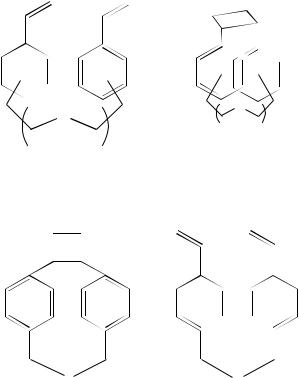
276 |
William M. Horspool |
|
O |
O |
|
n |
|
|
n |
|
n = 1 |
(123) |
(124) |
para - attachment |
85% |
|
n = 1 |
meta - attachment |
40% |
n = 2 |
para - attachment |
63% |
n = 2 |
meta - attachment |
mixture of cis 26% and trans 6% |
X |
X |
(125) X = S or Se, SiMe2 |
(126) |
has also been examined59. A natural extension of the study has been the development of synthetic approaches to crown-ether based systems. These (128) can be formed in high yield (up to 90%) by the irradiation > 280 nm of the derivatives (127). Some evidence for the involvement of biradicals within the cycloaddition process was found from the fact that a low yield of 129 was obtained. This is presumed to be the result of trapping of the biradical by oxygen60,61. The high yield of adducts obtained from these irradiations is thought to be due to the flexibility of the ether linkages that permits facile face- to-face approach of the two alkenyl groups. The use of the (2 C 2)-photocycloaddition reactions in the synthesis of so-called paddlanes (130) has been studied. Irradiations of the starting materials (131) are carried out through Pyrex and yields are best when cyclohexane is used as the solvent. The yields of the adducts formed by the double (2 C 2)-cycloaddition which forms two cyclobutane moieties is excellent. These products are accompanied by small amounts of the cycloaddition product 132 formed by a single (2 C 2)-cycloaddition process62. Other cyclophanes with two cyclobutane moieties have also been isolated following the irradiation of the derivative 133. In this instance, however, the yields are not good and the three isomers 134, 135 and 136 are obtained in a total yield of 20%63. Further examples of compounds of this type have been synthesized by cyclization of 13764.
